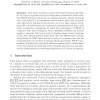Free Online Productivity Tools
i2Speak
i2Symbol
i2OCR
iTex2Img
iWeb2Print
iWeb2Shot
i2Type
iPdf2Split
iPdf2Merge
i2Bopomofo
i2Arabic
i2Style
i2Image
i2PDF
iLatex2Rtf
Sci2ools
ECCV
2000
Springer
2000
Springer
Learning to Recognize 3D Objects with SNoW
This paper describes a novel view-based learning algorithm for 3D object recognition from 2D images using a network of linear units. The SNoW learning architecture is a sparse network of linear functions over a pre-defined or incrementally learned feature space and is specifically tailored for learning in the presence of a very large number of features. We use pixel-based and edge-based representations in large scale object recognition experiments in which the performance of SNoW is compared with that of Support Vector Machines (SVMs) and nearest neighbor using the 100 objects in the Columbia Image Object Database (COIL-100). Experimental results show that the SNoW-based method outperforms the SVM-based system in terms of recognition rate and the computational cost involved in learning. Most importantly, SNoW's performance degrades more gracefully when the training data contains fewer views. The empirical results also provide insight into practical and theoretical considerations o...
Columbia Image Object | Computer Vision | ECCV 2000 | Recognition Rate | SNoW Learning Architecture | View-based Learning Algorithm | View-based Methods |
| Added | 16 Oct 2009 |
| Updated | 16 Oct 2009 |
| Type | Conference |
| Year | 2000 |
| Where | ECCV |
| Authors | Ming-Hsuan Yang, Dan Roth, Narendra Ahuja |
Comments (0)

